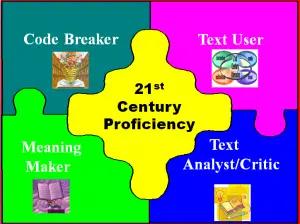 What I really appreciate about the four resource model is that it does not discard the knowledge that the teachers have already acquired. What Honan (2004) did in her project is to encourage the teachers to reflect on their teaching strategies and come up with a plan that would help them create a more balanced class, where all four areas (code breaker, meaning maker, text user, and text analyst) are explored. At the same time familiarization with Freebody & Luke’s (1999) four resource model and with what exactly each category means, is also important.
What I really appreciate about the four resource model is that it does not discard the knowledge that the teachers have already acquired. What Honan (2004) did in her project is to encourage the teachers to reflect on their teaching strategies and come up with a plan that would help them create a more balanced class, where all four areas (code breaker, meaning maker, text user, and text analyst) are explored. At the same time familiarization with Freebody & Luke’s (1999) four resource model and with what exactly each category means, is also important.
Honan’s (2004) chapter provided a good example of how the four resource model can be used to map possible classroom practices. Applied to my own educational context, I found it useful to understand that when mapping possible practices it is important to concentrate “on teaching strategies rather than learning activities” (p.44). When writing lesson plans my focus is mainly on what the students will be doing and I rarely mention anything about what the teacher will do, what strategies will be employed.
As a matter of fact, this has happened only in the past few years, as I had to adapt to the requirements of the school I am working for at the moment. But Honan (2004) reminded me of my Certificate in English Language Teaching to Adults (Cambridge CELTA) training where we were taught to be very explicit, to have many details in our lesson plans. The lesson plan template had both a column reserved for what the students will be doing and one for what the teachers will be doing. Actually, the Cambridge CETLA instructor required us to write exactly the words we would be using, the questions we would ask, and even the expected answers.
References:
- Freebody P. & Luke A. (1999). Further notes on the four resource model. Retrieved November 13, 2008.
- Honan, E. & Healy, A. (2004). Using the four resource model as a map of possible practices. In A. Healy & E. Honan (Eds.), Text Next: New resources for literacy learning (pp. 37-49). Newtown NSW: Primary English Teaching Association.
Image source

